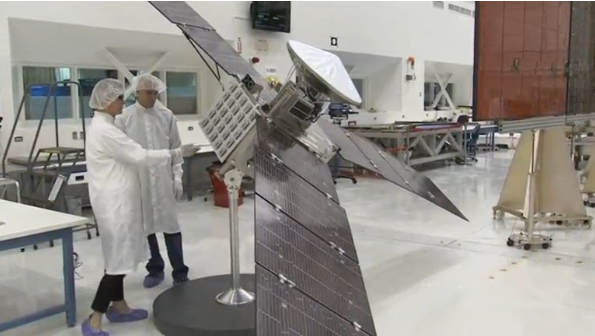
CALIFORNIA, United States (Reuters) — After nearly a five year wait, scientists at NASA will get their very first close-encounter with Jupiter. Launched in August of 2011, the Juno spacecraft will enter into orbit around the largest planet in the solar system on July 04 after a 445-million mile (716-million km) journey.
On Thursday (June 09), NASA’s Jet Propulsion Laboratory opened the doors to one of their ‘clean rooms’ which held a large, 1/4 scale model of Juno, as well as a full-size, test replica of one of its solar panel wings.
“So July 4th is the day we make the transition from being in orbit around the sun to being in orbit around Jupiter,” said Juno Principal Investigator Scott Bolton. “So we have to slow down so that we can get into orbit around Jupiter and we have to fire a rocket at just the right time and just the right amount of time and we have to be facing in the right direction when we fire that rocket, and if that doesn’t happen just right, you just fly right past Jupiter and that’s it. You don’t come back for, I don’t know, 6000 years or something crazy like that. So you have to get in orbit there in order to have a mission.”
Juno is to spend a year in an unprecedented polar orbit around the giant planet, measuring its water content, mapping its magnetic fields and searching for signs of a solid core.
With more than twice the mass than all its sibling planets combined, Jupiter is believed to hold a key piece to the puzzle of how the planets formed some 4.65 billion years ago from the gas and dust left over after the birth of the sun.
“One of the first priority things, is just to learn about how Jupiter formed. What is it like inside? What is it exactly made out of? How much water and oxygen are inside the planet? And how is it structured inside, so that we can put together the idea of how the rest of the solar system is made. How did Jupiter get made from the leftovers of the sun? And what does that tell us about how planets in general are made?” said Bolton.
To make its observations, Juno will soar as close as 3,100 miles (5,000 km) above Jupiter’s cloud tops, the first spacecraft to fly inside the planet’s radiation belts. Because of the severe environment, Bolton said they took extreme measures outfitting the spacecraft.
“Juno is probably the most shielded spacecraft ever flown. We’re moving faster than any spacecraft has ever gone. By the time that we arrive at Jupiter and fire our engines, we’ll be the fastest human-made object in history. And so we’re screaming past this planet, super close, in an intense radiation environment and we’ve given every advantage that we know to be, it’s the most armored tank we’ve ever built.”
Juno should last through 33 orbits around Jupiter, which is about a year on Earth. Its last maneuver will be a suicidal plunge into the planet’s thick atmosphere, which will incinerate the probe to avoid possible contamination of Jupiter’s water-bearing moons.







